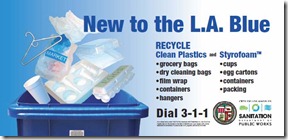Durham, North Carolina currently generates 14,500 tons of recyclable material. When 4,500 tons more is recycled, it will warrant its own material recovery facility (MRF,) something being strongly encouraged by Steve Schewel, a friend and member of the City Council here.
The fact that recycling is measured by the ton is one of the reasons so many municipalities haven’t moved to recycling plastic film and bags as well as polystyrene or foams such as Dow Chemical’s trademark Styrofoam.
These tiny though highly visible and troublesome slivers of the waste stream weigh hardly anything but they are recyclable, and in the case of foam or polystyrene, infinitely so.
They are also many times more effective and foam is as much as 1/10th the cost of alternatives, an important consideration for small independent restaurants.
Polystyrene or plastic foam is #6 in the triangles on materials that signify content. Here is a white paper about how communities can recycle it, prepared by the polystyrene brand Dart, a foodservice container supplier that began experimenting with the material in the 1950s.
The white paper encourages communities such as Durham to begin recycling plastic foam and lays out the process and some of the challenges as well as solutions. In a full-cost accounting sense, the costs involved would be built into the costs of the product.
Until then, places such as Durham need to join the many others that divert polystyrene foam from landfills into curbside and other recycling. The process is simple and uses a minimal amount of resources but a full pallet of densified foam will weight only approximately 1,000 lbs.
Packaging peanuts are made from a variety of materials so the overview notes they should be kept in their current form and resold or put back into use.
Peanut recycling is done by American LAbor, another friend’s company in Durham that supplies equipment for medical diagnostics as well as by thousands of small packaging and shipping stores.
Foam polystyrene is already being picked up as trash or in many cases by curbside recycling because Durham residents have learned to understand the meaning of the triangle recyclable symbol but not the meaning of all of the various numbers.
Unfortunately, recycling including inclusion of this material curbside is only part of the solution and may have little impact on the 4% of the general public who intentionally litter or the 17% who do because a container is not close by.
I find the cost/benefit analysis at this link that was conducted for Seattle a few years ago very enlightening for those predisposed to seek bans as an alternative.
Just as full-cost accounting should include the costs of recovery for these materials, life-cycle assessments are being used now to assess alternatives. Many such studies have comparing the impact of various drinking cups have found that reusable cups have the higher negative impact on the environment.
One thing is certain, when Durham warrants its own MRF, eliminating the need of a transfer station, it will become even simpler to recycle plastic foam.
1 comment:
I am so against foam take-out containers. I understand they do the job of keeping food hot while transporting home but foam is so bad for the environment and there are so many other great alternatives!
Post a Comment